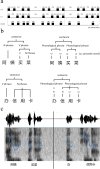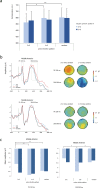Rhythmic pattern facilitates speech production: An ERP study
- PMID: 31506472
- PMCID: PMC6736834
- DOI: 10.1038/s41598-019-49375-8
Rhythmic pattern facilitates speech production: An ERP study
Abstract
Rhythm affects the speech perception of events unfolding over time. However, it is not clear to what extent the rhythm could affect the processes of sentence speech production. In this event-related potential (ERP) study, we examined whether a particular rhythmic pattern could affect the planning of speech production before articulation. We recorded electrophysiological (EEG) and behavioural (reaction time) data while participants read aloud a target speech in Chinese. Target speeches were sentences or phrases consisting four characters, with regular (e.g., the 2 + 2 pattern; numbers in the brackets represent the number of syllables) or irregular (e.g., 1 + 3) rhythmic patterns, which were preceded by congruent or incongruent musical rhythmic patterns formed by simple pure tones with different temporal intervals. Behavioural and ERP findings indicated a rhythmic priming effect in comparing congruent and incongruent conditions in the regular target speeches, but not in the irregular ones. An early component (N100) that was elicited in response to target speeches that were rhythmically mismatched to primes was linked to the detection of hierarchical linguistic units, which did not conform to expectations. A later negative component (N400) was thought to reflect the violation of expectation on rhythmic pattern in speech production. These findings suggest that rhythmic pattern constrains grammatical and prosodic encoding during speech production, and support the hypothesis that speakers form a grammatical or a prosodic abstract frame before articulation.
Conflict of interest statement
The authors declare no competing interests.
Figures


Similar articles
-
Theta Band (4-8 Hz) Oscillations Reflect Online Processing of Rhythm in Speech Production.Brain Sci. 2022 Nov 22;12(12):1593. doi: 10.3390/brainsci12121593. Brain Sci. 2022. PMID: 36552053 Free PMC article.
-
Rhythmic priming enhances the phonological processing of speech.Neuropsychologia. 2012 Sep;50(11):2652-8. doi: 10.1016/j.neuropsychologia.2012.07.018. Epub 2012 Jul 22. Neuropsychologia. 2012. PMID: 22828660
-
Speech rhythm facilitates syntactic ambiguity resolution: ERP evidence.PLoS One. 2013;8(2):e56000. doi: 10.1371/journal.pone.0056000. Epub 2013 Feb 8. PLoS One. 2013. PMID: 23409109 Free PMC article.
-
Rhythm in language acquisition.Neurosci Biobehav Rev. 2017 Oct;81(Pt B):158-166. doi: 10.1016/j.neubiorev.2016.12.012. Epub 2016 Dec 16. Neurosci Biobehav Rev. 2017. PMID: 27993604 Review.
-
Space and time in models of speech rhythm.Ann N Y Acad Sci. 2019 Oct;1453(1):47-66. doi: 10.1111/nyas.14102. Epub 2019 May 21. Ann N Y Acad Sci. 2019. PMID: 31115071 Review.
Cited by
-
Language switching is modulated by emotion priming: evidence from behavioral and event-related potentials study.Front Psychol. 2024 Dec 2;15:1373636. doi: 10.3389/fpsyg.2024.1373636. eCollection 2024. Front Psychol. 2024. PMID: 39687565 Free PMC article.
-
Tension experience induced by tonal and melodic shift at music phrase boundaries.Sci Rep. 2022 May 18;12(1):8304. doi: 10.1038/s41598-022-11949-4. Sci Rep. 2022. PMID: 35585148 Free PMC article.
-
Segmentation window of speech information processing in the human auditory cortex.Sci Rep. 2024 Oct 24;14(1):25044. doi: 10.1038/s41598-024-76137-y. Sci Rep. 2024. PMID: 39448758 Free PMC article.
-
Theta Band (4-8 Hz) Oscillations Reflect Online Processing of Rhythm in Speech Production.Brain Sci. 2022 Nov 22;12(12):1593. doi: 10.3390/brainsci12121593. Brain Sci. 2022. PMID: 36552053 Free PMC article.
-
Linear incrementality in focus and accentuation processing during sentence production: evidence from eye movements.Front Hum Neurosci. 2025 Jan 7;18:1523629. doi: 10.3389/fnhum.2024.1523629. eCollection 2024. Front Hum Neurosci. 2025. PMID: 39845409 Free PMC article.
References
-
- Fromkin VA. The non-anomalous nature of anomalous utterances. Language. 1971;47(1):27–52. doi: 10.2307/412187. - DOI
-
- Garrett, M. F. The analysis of sentence production. In G. Bower,. Psychology of learning and motivation, 9. New York: Academic Press, 505–529 (1975).
-
- Bock K. Syntactic persistence in language production. Cogn Psychol. 1986;18(3):355–387. doi: 10.1016/0010-0285(86)90004-6. - DOI
-
- Pickering MJ, Branigan HP. The representation of verbs: Evidence from syntactic priming in language production. J Mem Lang. 1998;39(4):633–651. doi: 10.1006/jmla.1998.2592. - DOI
Publication types
MeSH terms
LinkOut - more resources
Full Text Sources
Other Literature Sources
Molecular Biology Databases

